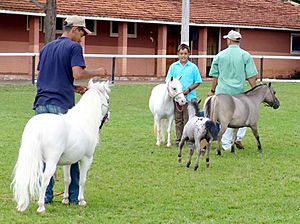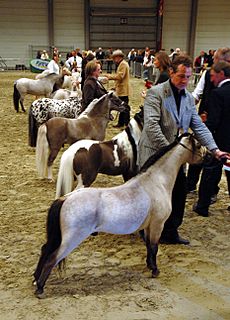Miniature horse facts for kids

Miniature horse at show in Europe
|
|
| Distinguishing features | Small size, with horse phenotype 34–38 inches (86–97 cm) at the withers |
|---|---|
| Horse (Equus ferus caballus) | |
Miniature horses are special horses known for their small size. You can find them in many countries, especially in Europe and the Americas. They became this small over hundreds of years because people carefully chose which horses to breed. This is called selective breeding.
These tiny horses are usually less than 34–38 inches (86–97 cm) tall at their withers. The withers is the highest part of their back, between their shoulder blades. Even though they are small enough to be called ponies, many miniature horses look just like regular-sized horses. Because of this, horse clubs often call them "horses." They come in many different colors and patterns.
Miniature horses are usually bred to be friendly and good with people. This makes them popular as family pets. But remember, they are still real horses! They act like other horses, including having a natural fight or flight instinct. So, you must treat them like any full-sized horse, even if they are mostly a companion animal.
These clever horses can also be trained as service animals, just like assistance dogs. They can help people with disabilities. Miniature horses also compete in horse shows. They can learn driving (pulling carts), equine agility (like an obstacle course), and other fun events.
Contents
What Makes Miniature Horses Special?
In the United States, there are two main groups that register miniature horses. These are the American Miniature Horse Association (AMHA) and the American Miniature Horse Registry (AMHR). The AMHA started in 1978. It wanted to make sure miniature horses were seen as their own special breed. Many groups around the world work with the AMHA.
The AMHR is part of the American Shetland pony Club. It became a separate registry in 1972. Around the world, there are many groups for miniature horses. Some groups want miniatures to look like regular horses. Others prefer them to look more like ponies. There are also groups for specific miniature breeds, like the Falabella horse.
Height and Appearance Standards
For the AMHR, miniature horses cannot be taller than 38 inches at their withers. The AMHR has two groups: "A" for horses 34 inches (86 cm) and under, and "B" for horses 34 to 38 inches (86 to 97 cm). The AMHA requires horses to be under 34 inches tall.
Miniature horses can have any coat color or white markings. The AMHA says that if you saw a picture of a miniature horse without anything to show its size, it should look exactly like a full-sized horse. It should have the same body shape and proportions. The AMHR says a miniature horse should be strong, balanced, and alert. They should also be friendly and eager, but not easily scared.
Miniature Horse Health
Miniature horses are usually very tough. They often live longer than some regular-sized horse breeds. On average, they live from 25 to 35 years. However, they can have some health issues more often than larger horses.
One common problem is eating too much, which leads to obesity. This often happens when owners are used to feeding full-sized horses. Dental problems are also common. Miniature horses have the same number of teeth as big horses, but in a much smaller mouth. This can cause teeth to be crowded. They might also have overbites or underbites. Sometimes, their baby teeth don't fall out when they should.
These dental issues, combined with overeating, can lead to more cases of colic. Colic is a type of stomach pain. A serious problem for miniature horses is hyperlipemia. This is when stress makes their body break down too much fat, which can hurt their liver. Giving birth can also be harder for miniature horses. But most health problems can be fixed with proper feeding and care.
History of Miniature Horses
Miniature horses first appeared in Europe in the 1600s. By 1765, rich people often kept them as pets. Some were also used in coal mines in England and Europe. Small ponies were used in English mines after a law in 1842 stopped young children from working there. Shetland ponies were common, but any small, strong pony that fit in the mine shafts was used as a pit pony.
The first small horses came to the United States in 1861. John Rarey brought four Shetland ponies, one of which was only 24 inches (61 cm) tall. More small British and Dutch mine horses came to the US in the late 1800s. These small horses worked in coal mines in the eastern US until the mid-1900s. In the 1960s, people started to love miniature horses more. They began using them in many different horse activities.
Famous Miniature Breeds
The Falabella horse was first bred in Argentina in the mid-1800s by Patrick Newtall. After Newtall died, his son-in-law, Juan Falabella, took over. Juan added other horse types, like the Welsh Pony, Shetland pony, and small Thoroughbreds. By carefully breeding them, he was able to consistently get very small horses.
The South African Miniature Horse was developed in South Africa. These horses can look very different from each other. Some look like tiny Arabians, while others look like small draft horses. Wynand de Wet was the first to breed miniature horses in South Africa, starting in 1945. Other breeders followed, often using Arabian horses. In 1984, a group was started to register the breed. In 1989, the South African Miniature Horse was officially recognized as its own breed. There are about 700 registered miniature horses in South Africa.
How Miniature Horses Are Used
There are many horse shows for miniature horses around the world. They can compete in lots of different events. These include halter (judging their body shape), in-hand hunter and jumper (leading them over obstacles), driving (pulling a cart), liberty (showing off without a lead), costume, obstacle courses, and showmanship.
Miniature horses are also wonderful companion animals and pets. They are great for children, older people, and people who are blind or have other disabilities. They are often less scary than full-sized horses. Even though miniature horses can be trained to work indoors, they are still real horses. They are healthiest when they can live outdoors with proper shelter and room to run, when they are not working with people.
See also
 In Spanish: Caballo miniatura para niños
In Spanish: Caballo miniatura para niños




